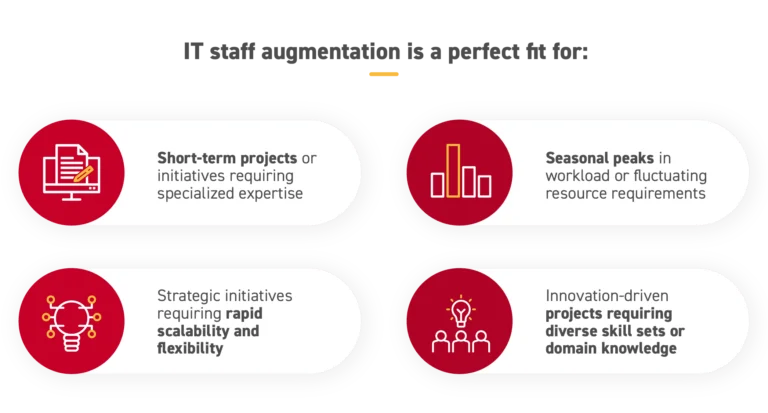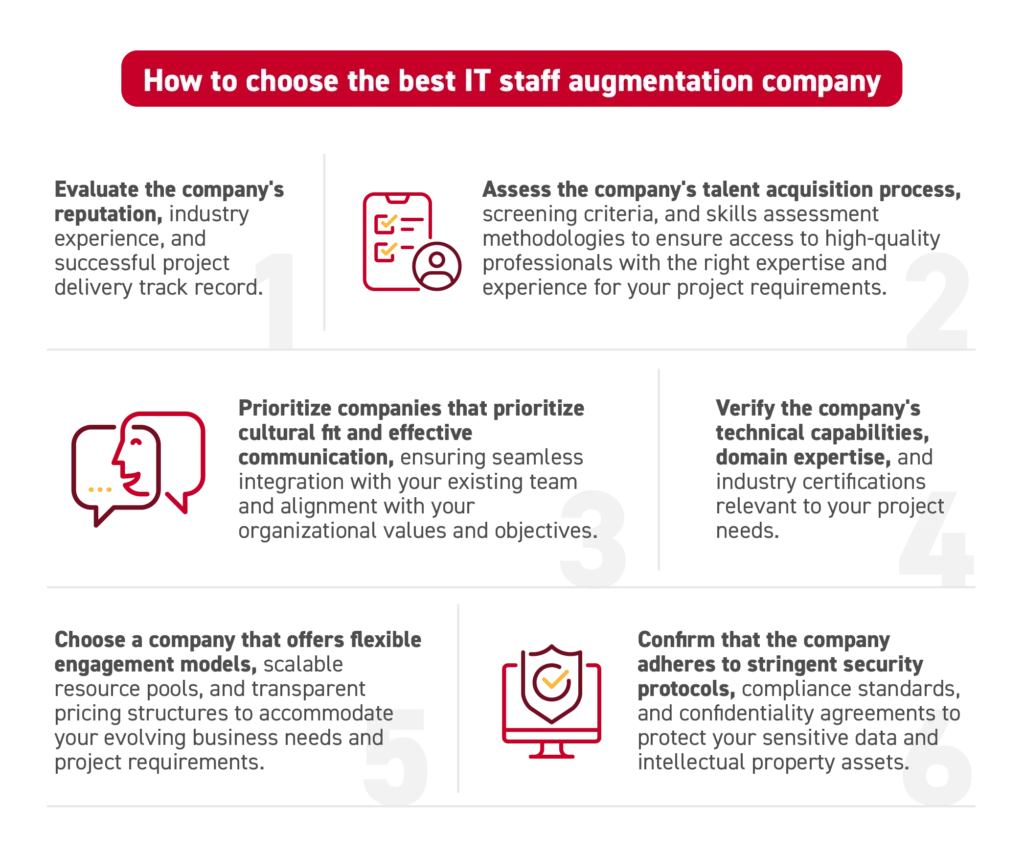
“IT staff augmentation challenges” refers to the difficulties or obstacles met when implementing staff augmentation strategies in the field of information technology (IT).
That is why in this article, we delve into the critical hurdles faced in this hiring model, provide actionable solutions, tips and more to overcome them.
By continuing to read, you will gain valuable insights, ensuring smooth project execution, and maximizing the benefits of this strategic hiring model.
What is IT Staffing Augmentation?
IT staff augmentation is a strategic hiring model where companies supplement their existing IT teams with external talent to fulfill specific skill gaps or project needs.
Unlike traditional hiring, where companies recruit permanent employees, this model offers flexibility by providing temporary assistance, usually on a contract basis.
This approach allows businesses to scale their workforce up or down based on project demands without the long-term commitment or overhead costs associated with full-time hires.
When Should the Utilization of Staff Augmentation be Considered?

Top Challenges of IT Staff Augmentation
This is a popular strategy among businesses to address their IT manpower requirements. However, despite its benefits, it poses certain challenges that companies must address to achieve successful outcomes.
Some of the top challenges of IT staff augmentation include:
Skill Mismatch
One common challenge in IT staff augmentation is finding the right talent with the necessary skills and experience.
Companies may need help identifying candidates who precisely fit their project requirements, leading to delays and inefficiencies.
You can address this by partnering with a reputable IT staffing agency that can streamline the recruitment process.
These agencies have access to a vast network of qualified professionals and employ rigorous screening procedures to ensure the candidates’ suitability.
Additionally, leveraging skill assessment tests and technical interviews can help validate candidates’ expertise before onboarding them.
#HeinsohnTip: Clearly define the project scope and required skill sets upfront to align expectations and avoid miscommunication during hiring.
Discover how to find the right software developer recruiter for your company.
Cultural Fit
Integrating external resources into an existing team can pose cultural alignment and collaboration challenges. Mismatched work styles or communication barriers may hinder productivity and cohesion within the team.
You can manage this issue by prioritizing cultural fit by assessing candidates’ values, work habits, and interpersonal skills during the selection process.
Encourage open communication and team-building activities to foster a sense of belonging and mutual respect among all team members.
#HeinsohnTip: Arrange introductory meetings or team-building exercises to facilitate rapport-building between existing staff and augmented resources.
Nearshore staff augmentation is a beneficial type of this model as it allows for smoother integration processes and enhances overall team cohesion thanks to proximity.
Knowledge Transfer
Knowledge transfer is crucial for ensuring continuity and sustainability within the organization. However, transferring domain-specific knowledge and project insights to augmented staff can be time-consuming and challenging.
One strategy to avoid this challenge is implementing knowledge-sharing mechanisms such as documentation, training sessions, and mentorship programs to facilitate smooth integration and information exchange.
Encourage regular updates and feedback loops to ensure that augmented staff stays aligned with project objectives and organizational goals.
#HeinsohnTip: Leverage technology platforms and collaboration tools to centralize project documentation and facilitate real-time knowledge sharing among team members.
Check out our latest guide on how to effectively scale your IT development team for success.
Management Oversight
Managing a hybrid team comprising internal and external resources requires effective coordination and oversight.
Without proper management protocols in place, there is a risk of miscommunication, duplication of efforts, and project delays.
We recommend establishing clear reporting structures, communication channels, and project management frameworks to monitor progress, resolve issues, and ensure accountability across the team.
Regular check-ins, status updates, and performance evaluations can help track project milestones and identify any areas needing improvement.
#HeinsohnTip: Assign a dedicated project manager or team lead responsible for orchestrating the activities of both internal and external resources, fostering collaboration, and driving project success.
Cost Management
While staff augmentation offers cost advantages compared to traditional hiring models, managing budgetary constraints and optimizing resource allocation can be challenging.
Businesses can conduct a thorough cost-benefit analysis to evaluate the financial implications of staff augmentation versus in-house hiring or outsourcing.
Set clear budgetary guidelines and monitor resource utilization to identify areas for optimization and cost savings.
#HeinsohnTip: Negotiate flexible contract terms with staffing agencies to accommodate fluctuations in resource requirements and minimize financial risk.
Security and Compliance
Integrating external resources into sensitive IT environments raises concerns regarding data security, regulatory compliance, and intellectual property protection.
One way to manage this challenge is by implementing robust security protocols, access controls, and confidentiality agreements to safeguard sensitive information and mitigate cybersecurity risks.
Conduct background checks and security screenings for augmented staff to ensure compliance with regulatory requirements and industry standards.
#HeinsohnTip: Clearly define roles and responsibilities, access privileges, and data handling procedures to maintain transparency and accountability in data management practices
Advantages of Utilizing IT Resource Augmentation Services
Having IT staff can bring about a lot of great benefits that can help make our workday smoother and more efficient! Here are some of the most important:
- You can enjoy the freedom to adjust the size of your workforce according to your projects’ needs without making a long-term commitment or bearing the overhead expenses associated with hiring full-time employees.
- By tapping into a vast talent pool, companies can achieve their goals faster, with greater efficiency, and at a lower cost than relying solely on their own internal resources.
- Businesses can optimize resource allocation and control labor costs by paying only for services rendered, eliminating recruitment, onboarding, and employee benefits expenses.
- Also, by leveraging external talent accelerates project timelines and reduces time-to-market, enabling businesses to capitalize on market opportunities and gain a competitive edge.
We have created an article explaining the advantages of IT staff augmentation to help you understand this model better.
A Quick Guide to Selecting an IT Staff Augmentation Company
When choosing an IT staff augmentation company, it is essential to consider the following factors.
By carefully assessing these factors and aligning them with your business goals and project requirements, you can select the best partner that best fits your needs and maximizes the value of your investment.

FAQs
What is the difference between T&M and staff augmentation?
What are the risks of staff augmentation?
What is the IT staff augmentation process?
The process involves:
- identifying project needs,
- defining skill requirements,
- sourcing external talent,
- screening candidates,
- onboarding selected resources,
- integrating them into the team and
managing their performance and progress throughout the project lifecycle.





